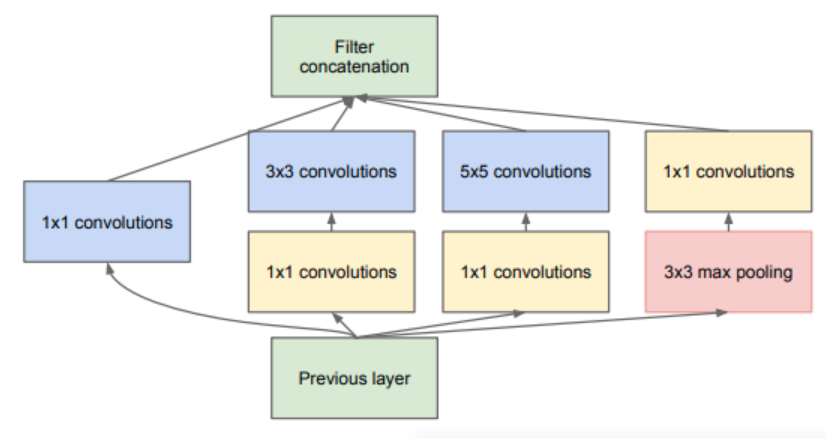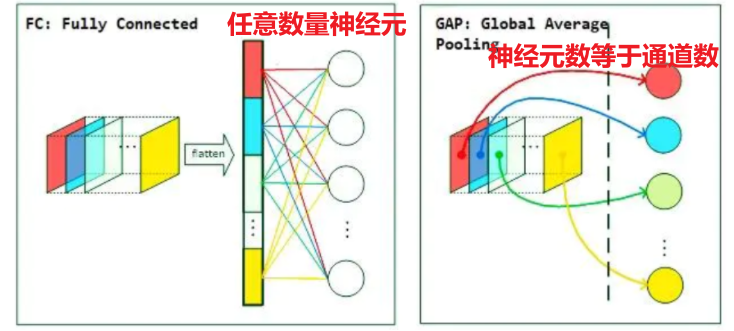1
2
3
4
5
6
7
8
9
10
11
12
13
14
15
16
17
18
19
20
21
22
23
24
25
26
27
28
29
30
31
32
33
34
35
36
37
38
39
40
41
42
43
44
45
46
47
48
49
50
51
52
53
54
55
56
57
58
59
60
61
62
63
64
65
66
67
68
69
70
71
72
73
74
75
76
77
78
79
80
81
82
83
84
85
86
87
88
89
90
91
92
93
94
95
96
97
98
99
100
101
102
103
104
105
106
| import torch
from torch import nn
from torchsummary import summary
class Inception(nn.Module):
def __init__(self, in_channels, c1, c2, c3, c4):
super(Inception, self).__init__()
self.ReLU = nn.ReLU()
self.p1_1 = nn.Conv2d(in_channels=in_channels, out_channels=c1, kernel_size=1)
self.p2_1 = nn.Conv2d(in_channels=in_channels, out_channels=c2[0], kernel_size=1)
self.p2_2 = nn.Conv2d(in_channels=c2[0], out_channels=c2[1], kernel_size=3, padding=1)
self.p3_1 = nn.Conv2d(in_channels=in_channels, out_channels=c3[0], kernel_size=1)
self.p3_2 = nn.Conv2d(in_channels=c3[0], out_channels=c3[1], kernel_size=5, padding=2)
self.p4_1 = nn.MaxPool2d(kernel_size=3, padding=1, stride=1)
self.p4_2 = nn.Conv2d(in_channels=in_channels, out_channels=c4, kernel_size=1)
def forward(self, x):
p1 = self.ReLU(self.p1_1(x))
p2 = self.ReLU(self.p2_2(self.ReLU(self.p2_1(x))))
p3 = self.ReLU(self.p3_2(self.ReLU(self.p3_1(x))))
p4 = self.ReLU(self.p4_2(self.p4_1(x)))
return torch.cat((p1, p2, p3, p4), dim=1)
class GoogLeNet(nn.Module):
def __init__(self, Inception):
super(GoogLeNet, self).__init__()
self.b1 = nn.Sequential(
nn.Conv2d(in_channels=3, out_channels=64, kernel_size=7, stride=2, padding=3),
nn.ReLU(),
nn.MaxPool2d(kernel_size=3, stride=2, padding=1))
self.b2 = nn.Sequential(
nn.Conv2d(in_channels=64, out_channels=64, kernel_size=1),
nn.ReLU(),
nn.Conv2d(in_channels=64, out_channels=192, kernel_size=3, padding=1),
nn.ReLU(),
nn.MaxPool2d(kernel_size=3, stride=2, padding=1))
self.b3 = nn.Sequential(
Inception(192, 64, (96, 128), (16, 32), 32),
Inception(256, 128, (128, 192), (32, 96), 64),
nn.MaxPool2d(kernel_size=3, stride=2, padding=1))
self.b4 = nn.Sequential(
Inception(480, 192, (96, 208), (16, 48), 64),
Inception(512, 160, (112, 224), (24, 64), 64),
Inception(512, 128, (128, 256), (24, 64), 64),
Inception(512, 112, (128, 288), (32, 64), 64),
Inception(528, 256, (160, 320), (32, 128), 128),
nn.MaxPool2d(kernel_size=3, stride=2, padding=1))
self.b5 = nn.Sequential(
Inception(832, 256, (160, 320), (32, 128), 128),
Inception(832, 384, (192, 384), (48, 128), 128),
nn.AdaptiveAvgPool2d((1, 1)),
nn.Flatten(),
nn.Linear(1024, 2))
for m in self.modules():
if isinstance(m, nn.Conv2d):
nn.init.kaiming_normal_(m.weight, mode="fan_out", nonlinearity='relu')
if m.bias is not None:
nn.init.constant_(m.bias, 0)
elif isinstance(m, nn.Linear):
nn.init.normal_(m.weight, 0, 0.01)
if m.bias is not None:
nn.init.constant_(m.bias, 0)
def forward(self, x):
x = self.b1(x)
x = self.b2(x)
x = self.b3(x)
x = self.b4(x)
x = self.b5(x)
return x
if __name__ == "__main__":
device = torch.device("cuda" if torch.cuda.is_available() else "cpu")
model = GoogLeNet(Inception).to(device)
print(summary(model, (1, 224, 224)))
|




